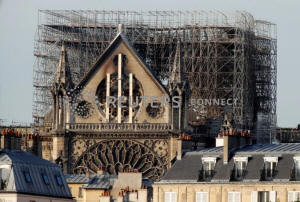|
Time-lapse shots of Notre-Dame spire may
yield clues on blaze
 Send a link to a friend
Send a link to a friend
 [April 18, 2019]
By Michel Rose and Julie Carriat [April 18, 2019]
By Michel Rose and Julie Carriat
PARIS (Reuters) - A time lapse camera
installed just hours before Monday's devastating blaze at Notre-Dame de
Paris may contain vital clues as to what caused the inferno, a French
scaffolding company working at the cathedral said on Thursday.
Europe Echafaudage was one of five companies contracted to restore
Notre-Dame's spire. The 90-metre (275-foot) collapsed in the blaze,
crashing through the cathedral's vaulted ceiling.
Footage from the camera, which was placed on the northern belltower and
is now in the hands of investigators, shows the first smoke coming out
of the spire's base, Marc Eskenazi, a representative for Europe
Echafaudage told Reuters.
"Shots were taken every 10 minutes starting from Monday at 2 p.m.,"
Eskenazi said. "Smoke can be seen on these images. It starts on the
south side" he said.
So far the authorities have said the fire appears accidental, although
they have not ruled out arson. Police sources say an electrical fault is
one possibility.

The office of Paris public prosecutor Remy Heitz did not respond to a
request for comment on the images.
Investigators have been able to access some areas of Notre-Dame,
including its two bell towers, though parts of the historic nave
remained too dangerous to enter more than 72 hours after the fire.
The damage to one of France's best loved monuments prompted an
outpouring of national sorrow and urgent calls for the authorities to
find out what caused the fire.
(Graphic: The fire at Notre-Dame - https://tmsnrt.rs/2XgGCRi)
Scaffolding specialist Europe Echafaudage, a unit of Le Bras Freres, a
family-owned business of 140 employees based in Lorraine in eastern
France, had almost finished erecting the scaffolding around the spire,
14 months after starting.
The company's 12-strong team was the only one working on site on the day
of the blaze.
Europe Echafaudage, and a second company involved in the project, Pro
Tech Foudre, have said they followed strict safety procedures.
Pro Tech Foudre, which was to start work removing the lightning rod that
ran down from the spire's top, described Europe Echafaudage as a
reputable company with a strong safety record and experience working on
prestigious sites, including the Pantheon and Louvre museum in Paris.
"These are very serious people. They go beyond the architects' demands.
When they're asked for a Porsche, they deliver a Rolls," said Anthony
Dupuy, manager of Pro Tech Foudre.
"There are other companies for which I'd have said they were asking for
it, but not this one."
Dupuy, who was involved in work to Notre-Dame in 2013, said safety
regulations were very strict at the centuries-old site, with a focus on
fire prevention. All extension chords had to be unplugged every night
and smoking was not allowed anywhere.
[to top of second column]
|

A view shows Notre-Dame Cathedral after a massive fire devastated
large parts of the gothic structure in Paris, France, April 18,
2019. REUTERS/Philippe Wojazer

TWO ALARMS
The scaffolders started leaving work at 5:20 p.m. on Monday evening
and by 5:50 p.m. - half an hour before the first alarm sounded - all
were gone, Eskenazi said.
"The procedure says that at the end of the day, electricity on the
site is turned off. So we turn off the lifts and the scaffolding's
lights, and we hand over the keys to the sacristy's concierge," he
said.
"That's exactly what the workers did. They followed the procedure,
and it was of course duly noted in the registers at the sacristy."
There was no welding machine or blowtorch on the site, he added.
Police sources confirmed no welding was being done at this stage to
the site.
The outside scaffolding had no sprinkler system, but was equipped
with movement detectors which did not go off, Eskenazi said. The
alarms that activated were the cathedral's own, he added. That may
also yield clues as to where the fire started.
Investigators are trying to understand why the fire was not detected
when the first alarm rang at 6:20 p.m., prosecutor Heitz has said. A
second alarm sounded at 6:43 p.m., at which point the fire was
detected in the roof.
An hour later, the spire, engulfed in flames, collapsed to the gasps
of hundreds of dumbstruck onlookers.

André Finot, Notre-Dame's spokesman said, there were "smoke
detectors everywhere" that were connected to the cathedral's safety
HQ at the presbytery, where a firefighter is posted 24 hours a day.
"If something goes off, there is an agent inside the cathedral who
can go make checks," Finot said. He said he was not able to comment
on the checks that were carried out after the first alarm sounded.
If indeed the fire was not arson, an electrical source would almost
certainly be to blame, one police source said.
"If it's an accident, there's a 90 percent chance it came from an
electric source, the police source said. "It was the only source of
energy in the building."
(Additional reporting by Emmanuel Jarry; Writing by Michel Rose;
Editing by Richard Lough and Raissa Kasolowsky)
[© 2019 Thomson Reuters. All rights
reserved.]
Copyright 2019 Reuters. All rights reserved. This material may not be published,
broadcast, rewritten or redistributed.
Thompson Reuters is solely responsible for this content. |